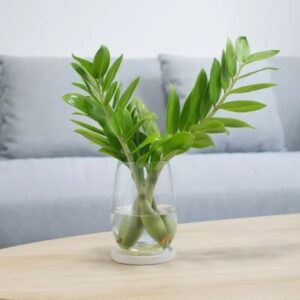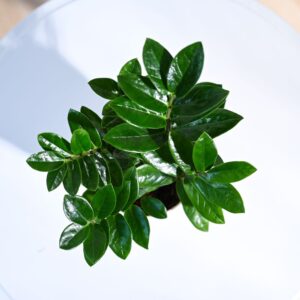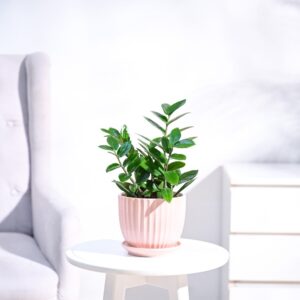how to Grow ZZ Plant: Complete Guide for Beginners
The ZZ plant, scientifically known as Zamioculcas zamiifolia, is a popular houseplant prized for its elegant, glossy green foliage and its ability to thrive in low-light environments. Native to Eastern Africa, this plant has become a favorite among indoor gardeners due to its attractive appearance and minimal care requirements. Its thick, waxy leaves grow in a graceful, feather-like pattern, making it a stylish addition to homes, offices, and interior landscapes.
One of the most remarkable features of the ZZ plant is its resilience. It can tolerate neglect, low humidity, infrequent watering, and even low levels of natural light, making it ideal for beginners or those with a busy lifestyle. The plant stores water in its thick rhizomes, which helps it survive drought conditions and irregular watering schedules.
With its combination of hardiness, beauty, and air-cleansing benefits, the ZZ plant stands out as a reliable and stylish choice for anyone looking to enhance their indoor space with greenery.

| Common Name | ZZ Plant, Zanzibar Gem, Eternity Plant |
| Botanical Name | Zamioculcas zamiifolia |
| Plant Type | Tropical perennial |
| Family | Araceae |
| Mature Size | 2- to 4-feet tall and wide |
| Soil Type | Well-draining |
| Sun Exposure | Bright to low indirect light |
| Soil pH | 6.0 – 7.0 |
| Flower Color | Yellow-brown spadix |
| Bloom Time | Spring |
How to Grow ZZ Plant
ZZ plants are low-maintenance houseplants even beginner gardeners can keep alive. Other than a pot with adequate drainage and a location away from cold drafts, these plants don’t require much. They thrive even in almost complete shade.
Watering
Water the ZZ plant only when the top 1–2 inches of soil feel dry. Avoid overwatering, as it can cause root rot. Use room-temperature water and ensure proper drainage. In winter, reduce watering frequency. Always let excess water drain out to keep the roots healthy and prevent moisture buildup.
Light
ZZ plants grow best in bright, indirect light but can tolerate low-light conditions, making them ideal for homes and offices. Avoid direct sunlight, as it can scorch the leaves. For optimal growth, place the plant near a window with filtered light or use artificial grow lights in darker spaces.
Soil
To grow a healthy ZZ plant, use well-draining soil that prevents waterlogging. A mix of regular potting soil, perlite, and cactus mix works best. This combination ensures proper aeration and prevents root rot. Avoid heavy or clay-rich soils, as they retain too much moisture and can harm the plant.
Fertilizer
Fertilize the ZZ plant once a month during spring and summer using a balanced liquid fertilizer diluted to half strength. Avoid over-fertilizing, as it can harm the roots. Do not fertilize in fall or winter when the plant is dormant. Proper feeding promotes healthy growth and vibrant, glossy leaves.
Temperature and Humidity
ZZ plants thrive in temperatures between 60°F to 75°F (15°C to 24°C) and prefer moderate humidity levels. They tolerate average indoor conditions well but should be kept away from cold drafts or heaters. Occasional misting can help in dry climates, though they generally adapt well to most humidity levels.
Pruning
Prune your ZZ plant to maintain its shape and remove yellow or damaged leaves. Use clean, sharp scissors or pruning shears. Cut stems at the base without harming healthy growth. Pruning also encourages new shoots and improves overall appearance. Perform pruning during the growing season for best results.
Propagating
Propagating a ZZ plant is a simple yet slow process, ideal for expanding your collection or sharing with others. The most common methods are leaf cuttings, stem cuttings, and division. For leaf propagation, cut a healthy leaf with a bit of stem and place it in moist soil or water. It may take several weeks to months for roots and rhizomes to develop.
For stem cuttings, cut a healthy stem with a few leaves, let it dry for a day, and plant it in well-draining soil. Keep the soil lightly moist and place it in bright, indirect light.
Division is the quickest method—simply separate the plant’s root ball into two or more sections, each with rhizomes and stems, and repot individually. Regardless of method, patience is key. Propagation is slow, but with proper care, new ZZ plants will eventually thrive.

Benefits of Growing ZZ Plant
| Low maintenance | Needs little attention, perfect for beginners |
| Tolerates low light | Thrives even in dimly lit areas |
| Drought-tolerant | Stores water in rhizomes and leaves |
| Air-purifying | Filters toxins from the air |
| Aesthetic appeal | Glossy leaves enhance interior decor |
Type of ZZ Plant
Zamioculcas zamiifolia (Standard ZZ Plant): The original variety with glossy, dark green oval-shaped leaves. It’s the most widely available and known for its tolerance to low light and drought.
Zamioculcas zamiifolia ‘Raven’ (Raven ZZ): Features deep purple-black leaves that start green and darken as they mature. This variety is eye-catching and adds a bold, modern touch to interiors.
Zamioculcas zamiifolia ‘Zenzi’: A dwarf cultivar with tightly packed, curled leaves. It’s more compact than the standard ZZ, making it great for small spaces or tabletops.
Variegated ZZ Plant: Rare and highly sought-after, this variety features green leaves marbled with creamy white or yellow variegation. It requires more light to maintain its variegation.

Common Pests and Diseases
ZZ plants are generally pest-resistant but can occasionally face issues.
Pests:
- Spider mites: Yellow stippling or webbing
- Mealybugs: White, cotton-like spots
- Scale: Brown bumps on stems
Use neem oil or insecticidal soap to treat infestations.
Diseases:
- Root rot: Caused by overwatering
- Leaf spot: Fungal or bacterial infections due to poor air circulation
Frequently Asked Questions (FAQs)
Q: How fast does a ZZ plant grow?
A: ZZ plants grow slowly and may produce only a few new shoots per year.
Q: Can ZZ plants live in windowless rooms?
A: Yes, but they need some artificial or indirect light. Growth will be slower.
Q: Why are my ZZ plant leaves turning black?
A: Likely due to overwatering or fungal infection. Check roots and adjust care.
Q: Is it okay to cut off yellow leaves?
A: Yes, prune yellow or damaged leaves to encourage healthy growth.
Conclusion
The ZZ plant is a stunning and nearly indestructible houseplant, perfect for any space—bright or dim, humid or dry. With minimal watering, well-draining soil, and occasional feeding, your ZZ plant will thrive for years to come. Whether you’re a new plant parent or a seasoned green thumb, growing a ZZ plant is a rewarding and effortless experience. Incorporate it into your home or workspace to enjoy both its beauty and the clean air it brings.


Pingback: How to Grow and Care for Swiss Cheese Plant - growupplant